Recently, I bought a set of Construction Attachments 42" Pallet Forks, for the BX. I bought them used, form user "oldballs". Mike is a great guy and I really appreciate him offering to sell these, to me.
Here's the forks I have:
Construction Attachments 42" Kubota BX series Pin-On pallet forks for LA203 and LA243 Loaders
The weight on this page says weight of the setup is 220 lbs. I have also seen 238 lbs. I don't know what they really weigh. They are heavy and very sturdy. Unfortunately, weight isn't a boon to the BX's limited lifting ability.
Today, I found some landscape edgers and pavers, for cheap. I loaded them in my 2013 Silverado 1500 2wd (stock height), on top of a pallet. This was to be my first use of the BX with the new pallet forks!!!
I knew it would be too heavy, but gave it a go, anyway. Altogether, there were 111 units. 99 of them were the interlock edgers. Around 85 of those were the normal size, which weigh around 12 pounds, each. The other 14ish are slightly smaller and probably weigh ten ponds. I also snagged some large pavers, weighing 10-35ish pounds, each.
I loaded the pallet with all the large interlock edgers and put the small ones around it, in the bed. The pavers were on top of the pallet. I figure I had around 1,400 pounds (+/- 250 lbs), in the bed of the truck.
For my BX25D-1, I opted to not get the QA, as it cuts down too much of the lift capacity and moves the load too far forward.
Removing the pins and installing them in the CA Pallet Forks cage was easy. I planned on a fight and all I got was grease on my hands and tools.
Having the cage on the back, allowed me to easily see in the bed of the pickup, to line up the forks and make sure I wasn't going to destroy anything.
Even though I knew it was too heavy, I gave it a shot. It budged, and took a little of the load off the pickup, but nothing worth noting. I started removing a few bricks at a time, until I had removed a lot of the bricks. Eventually, I could curl the cage, lifting the front, but it was pointless, as the back was still too low.
Here's where I was getting close:
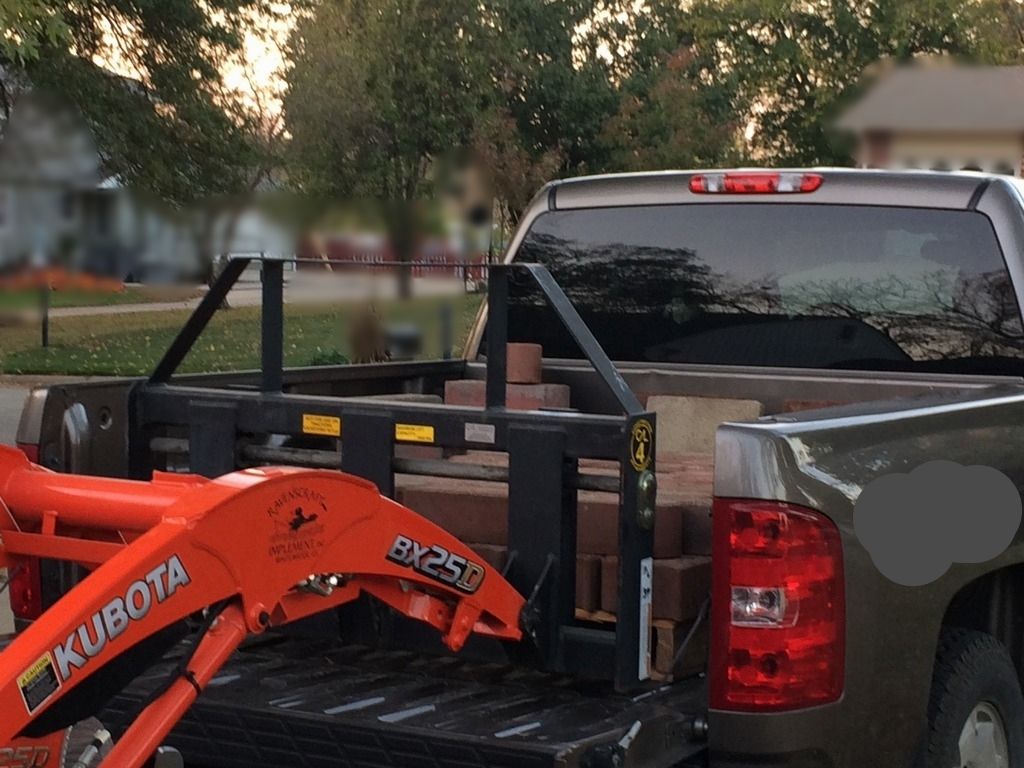
You can see the front lifting, but the back is still too heavy:
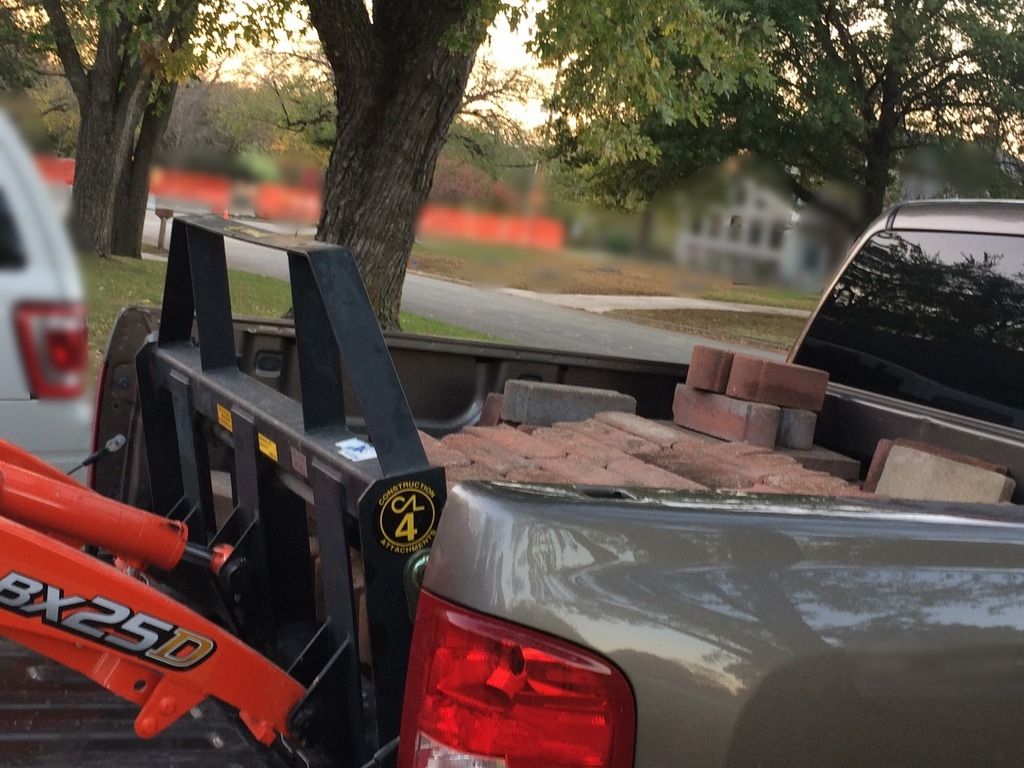
After removing a few more, this is what I was able to actually get out:
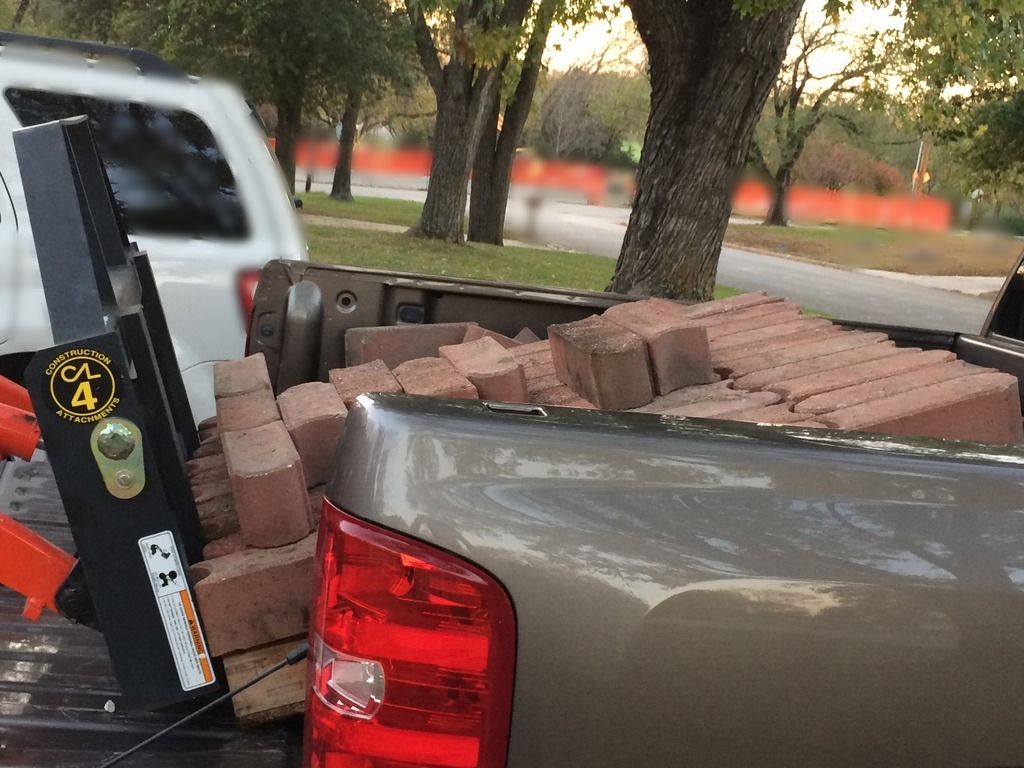
Got it out of the truck! This part was tricky. The lift arms didn't have enough power to actually lift it, but had enough to hold it. The curl function was able to pull it back, enough, I could get it off the bed. Of course, you have to get it a lot higher, than you start, because the bed will rise, as you lift the weight off. I made it pretty well, until the pallet hit the plastic cover, on top of the tailgate. That 1/16 of an inch plastic about caused a big problem, but I made it!
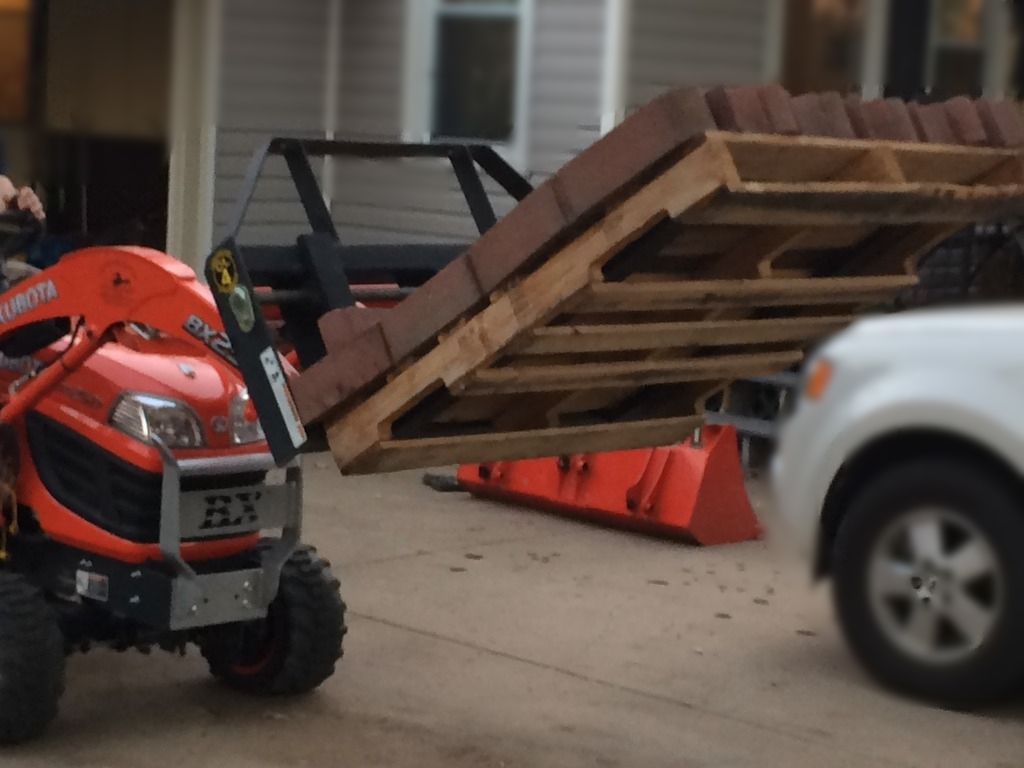
After I got it off the pickup, I had to negotiate the basketball goal. You can see how flattened the front tires were. They were set to the proper PSI, and verified, beforehand. I was glad I had the 680ish backhoe on and the rear tires loaded. Even with that, the steering was labored and I could really feel the weight of it. This makes sense, as if each of the 49 brick, on this load, weighs 12 pounds, each, that's a total of 588 pounds of bricks, plus the pallet, plus the 220/238 pound pallet forks.
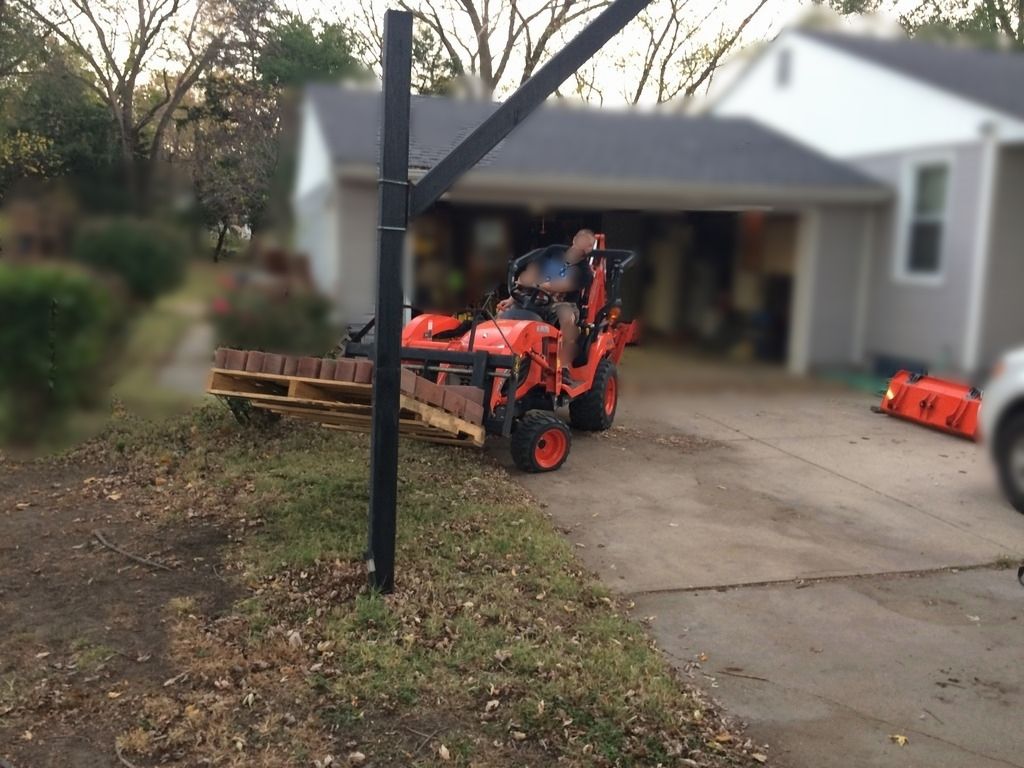
And, off to the back yard:

For the next load, since I had to offload a bunch of the first pallet, into the bed of the pickup, I took a second pallet, set it in the bed and loaded it up. I got roughly the same number on the second pallet, but couldn't get any of the large pavers on it, they just weigh too much. The problem I had with the second load was it couldn't be as heavy as the first. It had to be quite a bit lighter, since the truck had risen so much. I did add a few scratches, to the bed of the pickup and tailgate, which I expected.
What I thought was interesting was even when I got to the back yard, the lift arms would not raise. They held it, fine, but I could not raise them. It curled it fine, though. For those of you who think the competitors two curl cylinders are better than Kubota's one, it appears number doesn't matter as much as size. The arms have two smaller cylinders and can't do as much as the curl, which is a lot larger, but single cylinder. Obviously, two of the large ones would be even more powerful.
This use tells me Kubota's numbers are close. If you take the Pallet Forks weight at 220, the wood pallet weighs around 40 pounds, and the bricks weighed around 588 pounds, that gives a total weight of around 848 pounds; around 100 pounds more than Kubota rates the BX25D-1 at, at full height. I wasn't at full height, but I was over around/slightly over the halfway up height. If the forks weigh 18 pounds more, that's just that much better the BX did.
Just so you know, my BX had around 95 hours on it and was fully serviced at around 50 hours, including the SUDT2. I also Put a couple of shims in the pressure relief valve, early this year, bumping it up to near the factory spec'd 1,778. If I recall correctly, I'm around 1,780ish PSI. I've posted about it, elsewhere on this site.
Here's the forks I have:
Construction Attachments 42" Kubota BX series Pin-On pallet forks for LA203 and LA243 Loaders
The weight on this page says weight of the setup is 220 lbs. I have also seen 238 lbs. I don't know what they really weigh. They are heavy and very sturdy. Unfortunately, weight isn't a boon to the BX's limited lifting ability.
Today, I found some landscape edgers and pavers, for cheap. I loaded them in my 2013 Silverado 1500 2wd (stock height), on top of a pallet. This was to be my first use of the BX with the new pallet forks!!!
I knew it would be too heavy, but gave it a go, anyway. Altogether, there were 111 units. 99 of them were the interlock edgers. Around 85 of those were the normal size, which weigh around 12 pounds, each. The other 14ish are slightly smaller and probably weigh ten ponds. I also snagged some large pavers, weighing 10-35ish pounds, each.
I loaded the pallet with all the large interlock edgers and put the small ones around it, in the bed. The pavers were on top of the pallet. I figure I had around 1,400 pounds (+/- 250 lbs), in the bed of the truck.
For my BX25D-1, I opted to not get the QA, as it cuts down too much of the lift capacity and moves the load too far forward.
Removing the pins and installing them in the CA Pallet Forks cage was easy. I planned on a fight and all I got was grease on my hands and tools.
Having the cage on the back, allowed me to easily see in the bed of the pickup, to line up the forks and make sure I wasn't going to destroy anything.
Even though I knew it was too heavy, I gave it a shot. It budged, and took a little of the load off the pickup, but nothing worth noting. I started removing a few bricks at a time, until I had removed a lot of the bricks. Eventually, I could curl the cage, lifting the front, but it was pointless, as the back was still too low.
Here's where I was getting close:

You can see the front lifting, but the back is still too heavy:

After removing a few more, this is what I was able to actually get out:

Got it out of the truck! This part was tricky. The lift arms didn't have enough power to actually lift it, but had enough to hold it. The curl function was able to pull it back, enough, I could get it off the bed. Of course, you have to get it a lot higher, than you start, because the bed will rise, as you lift the weight off. I made it pretty well, until the pallet hit the plastic cover, on top of the tailgate. That 1/16 of an inch plastic about caused a big problem, but I made it!

After I got it off the pickup, I had to negotiate the basketball goal. You can see how flattened the front tires were. They were set to the proper PSI, and verified, beforehand. I was glad I had the 680ish backhoe on and the rear tires loaded. Even with that, the steering was labored and I could really feel the weight of it. This makes sense, as if each of the 49 brick, on this load, weighs 12 pounds, each, that's a total of 588 pounds of bricks, plus the pallet, plus the 220/238 pound pallet forks.

And, off to the back yard:

For the next load, since I had to offload a bunch of the first pallet, into the bed of the pickup, I took a second pallet, set it in the bed and loaded it up. I got roughly the same number on the second pallet, but couldn't get any of the large pavers on it, they just weigh too much. The problem I had with the second load was it couldn't be as heavy as the first. It had to be quite a bit lighter, since the truck had risen so much. I did add a few scratches, to the bed of the pickup and tailgate, which I expected.
What I thought was interesting was even when I got to the back yard, the lift arms would not raise. They held it, fine, but I could not raise them. It curled it fine, though. For those of you who think the competitors two curl cylinders are better than Kubota's one, it appears number doesn't matter as much as size. The arms have two smaller cylinders and can't do as much as the curl, which is a lot larger, but single cylinder. Obviously, two of the large ones would be even more powerful.
This use tells me Kubota's numbers are close. If you take the Pallet Forks weight at 220, the wood pallet weighs around 40 pounds, and the bricks weighed around 588 pounds, that gives a total weight of around 848 pounds; around 100 pounds more than Kubota rates the BX25D-1 at, at full height. I wasn't at full height, but I was over around/slightly over the halfway up height. If the forks weigh 18 pounds more, that's just that much better the BX did.
Just so you know, my BX had around 95 hours on it and was fully serviced at around 50 hours, including the SUDT2. I also Put a couple of shims in the pressure relief valve, early this year, bumping it up to near the factory spec'd 1,778. If I recall correctly, I'm around 1,780ish PSI. I've posted about it, elsewhere on this site.